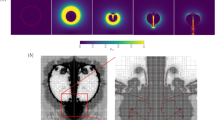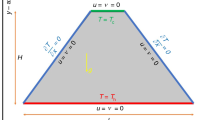Abstract
We investigated the cavitating flows around different axisymmetric bodies based on experiments and numerical simulation. In the numerical simulation, the multiphase Reynolds averaged Navier Stokes equations (RANS) were solved via the commercial computational fluid dynamics code CFX. The modified k-ω SST turbulence model was used along with the transport equation-based cavitation model. In the experiments, a high-speed video technique was used to observe the unsteady cavitating flow patterns, and the dynamic force measurement system was used to measure the hydrodynamics of the axisymmetric bodies under different cavitation conditions. Results are shown for the hemisphere bodies, conical bodies and blunt bodies. Reasonable agreements were obtained between the computational and experimental results. The results show that for the hemispherical body, the cavity consists of quasi-steady transparent region and unsteady foggy water-vapor mixture region, which contains small-scale vortices and is dominated by bubble clusters, causing irregular disturbances at the cavity interfaces. The curvature at the front of the conical body is larger, resulting in that the flow separates at the shoulder of the axisymmetric body. The cavity stretches downstream and reaches to a fixed cavity length and shape. For blunt bodies, the incipient cavitation number is larger than that for the hemispherical body. A large cloud cavity is formed at the shoulder of the blunt body in the cores of vortices in high shear separation regions and the re-entrant jet does not significantly interact with the cavity interface when it moves upstream. As to the dynamic characteristics of unsteady cavitating flows around the axisymmetric bodies, the pulsation frequency for the hemispherical body is larger than that for the blunt body. For the hemispherical body, the pulsation is mainly caused by the high-frequency, small-scale shedding at the rear end of the cavity, while for the blunt body, the main factor for the pulsation frequency is the periodically shedding of large-scale vortex cavities.
Similar content being viewed by others
References
C. E. Brennen, Cavitation and bubble dynamics, Oxford Engineering & Sciences Series 44, Oxford University Press, New York, USA (1995).
H. Sun, Numerical study of hydrofoil geometry effect on cavitating flow, Journal of Mechanical Science and Technology, 26 (8) (2012) 2535–2545.
B. Ji, X. W. Luo, X. X. Peng, Y. L. Wu and H. Y. Xu, Numerical analysis of cavitation evolution and exited pressure fluctuation around a propeller in non-uniform wake, International Journal of Multiphase Flow, 43 (2012) 13–21.
H. L. Liu, Y. Wang, D. X. Liu, S. Q. Yuan and J. Wang, Assessment of a turbulence model for numerical predictions of sheet-cavitating flows in centrifugal pumps, Journal of Mechanical Science and Technology, 27 (9) (2013) 2743–2750.
S. Park, and S. H. Rhee, Numerical analysis of the three-dimensional cloud cavitating flow around a twisted hydrofoil, Fluid Dynamics Research, 45 (2013) 1–20.
S. Park and S. H. Rhee, Computational analysis of turbulent supercavitating flow around a two-dimensional wedge-shaped cavitator geometry, Computers and Fluids, 70 (2012) 73–85.
B. Ji, X. W. Luo, R. E. A. Arndt and Y. L. Wu, Numerical simulation of three dimensional cavitation shedding dynamics with special emphasis on cavitation-vortex interaction. Ocean Engineering, 87 (2014) 64–77.
H. Rouse and J. S. McNown, Cavitation and pressure distribution: head forms at zero angle of yaw, Office of Naval Research, State University of lowa, Iowa City, USA (1948).
V. H. Arakeri and A. J. Acosta, Viscous effects in the inception of cavitation on axisymmetric bodies, Journal of Fluids Engineering, 95 (4) (1973) 519–527.
S. L. Ceccio and C. E. Brennen, Dynamics of attached cavities on bodies of revolution, Journal of Fluids Engineering, 114 (1992) 93–99.
H. Liu, Q. Liu zand T. Hu. An experimental study on fluctuating hydrodynamic loads on cavitating axisymmetric slender bodies, Journal of Hydrodynamics, 19 (6) (2004) 794–800.
D. Kim, W.-G. Park and C.-M. Jung, Numerical simulation of cavitating flow past axisymmetric body, International Journal of Naval Architecture and Ocean Engineering, 4 (3) (2012) 256–266.
Y. Kwack and S. H. Ko, Numerical analysis for supercavitating flows around axisymmetric cavitators, International Journal of Naval Architecture and Ocean Engineering, 5 (3) (2013) 323–332.
J. W. Lindau, R. F. Kunz, D. A. Boger, D. R. Stinebring and H. J. Gibeling, High Reynolds number, unsteady, multiphase CFD modeling of cavitating flows, ASME Journal of Fluid Engineering, 124 (2002) 607–616.
I. N. Kirchner, N. E. Fine and J. S. Uhlman, Numerical modeling of supercavitating flows, Anteon/Engineering Technology Center Mystic CT (2001).
R. F. Kunz, D. A. Boger and D. R. Stinebring, A preconditioned Navier-Stokes method for two-phase flows with application to cavitation prediction, AIAA paper, AIAA-99-3329 (1999).
J. W. Lindau, S. Venkateswaran, R. F. Kunz and C. L. Merkle, Computation of compressible multiphase flows, 41st Aerospace Sciences Meeting and Exhibit, Reno, Nevada (2003).
B. Huang and G. Y. Wang, Experimental and numerical investigation of unsteady cavitating flows through a 2D hydrofoil, Science China-Technological Sciences, 54 (7) (2011) 1801–1812.
B. Launder and D. Spalding, The numerical computation of turbulent flows, Computer Methods in Applied Mechanics and Engineering, 3 (1974) 269–289.
F. R. Menter, Improved two-equation k-ù turbulence models for aerodynamic flows, NASA Technical Memorandum, 103975, 34 (1993).
A. Ducoin, J. A. Astolfi, F. Deniset and J.-F. Sigrist, Computational and experimental investigation of flow over a transient pitching hydrofoil, European Journal of Mechanics/B Fluids, 28 (2009) 728–743.
O. Coutier-Delgosha, R. Fortes-Patella and J. Reboud, Evaluation of the turbulence model influence on the numerical simulations of unsteady cavitation, Journal of Fluids Engineering, 125 (1) (2003) 38–45.
C. L. Merkle, J. Feng and P. E. O. Buelow, Computational modeling of the dynamics of sheet cavitation, Proc. 3rd International Symposium on Cavitation, Grenoble, France (1998).
I. Senocak and W. Shyy, Evaluation of cavitation models for Navier-Stokes computations, Proceedings of FEDSM 02, ASME 2002 Fluids Engineering Division Summer Meeting, Montreal, Quebec, Canada (2002).
B. Huang, A. Ducoin and Y. L. Young, Physical and numerical investigation of cavitating flows around a pitching hydrofoil, Physics of Fluids, 25 (2013) 102109.
B. Huang, Y. L. Young, G. Y. Wang and W. Shyy, Combined experimental and computational investigation of unsteady structure of sheet/cloud cavitation, Journal of Fluid Engineering, 135 (2013) 071301.
J. Katz, Cavitation phenomena within regions of flow separation, Journal of Fluid Mechanics, 140 (1984) 397–436.
Author information
Authors and Affiliations
Corresponding author
Additional information
Recommended by Associate Editor Gihun Son
Wei Haipeng received his B.S. degree from Harbin Institute of Technology and M.S. degree from China academy of Launch Vehicle Technology. He is a doctoral student of Aerospace School of Tsinghua University majoring fluid dynamics. His research field includes computation of multiphase flow and experimental study on cavitation. He is involved in developing new computational methods of multiphase flow and advanced observation technology of cavitation.
Rights and permissions
About this article
Cite this article
Haipeng, W., Song, F., Qin, W. et al. Experimental and numerical research on cavitating flows around axisymmetric bodies. J Mech Sci Technol 28, 4527–4537 (2014). https://doi.org/10.1007/s12206-014-1020-7
Received:
Revised:
Accepted:
Published:
Issue Date:
DOI: https://doi.org/10.1007/s12206-014-1020-7




